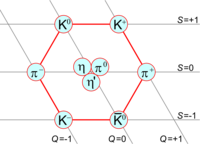
Pseudoscalar meson
Encyclopedia

Meson
In particle physics, mesons are subatomic particles composed of one quark and one antiquark, bound together by the strong interaction. Because mesons are composed of sub-particles, they have a physical size, with a radius roughly one femtometer: 10−15 m, which is about the size of a proton...
with total spin 0 and odd parity
Parity (physics)
In physics, a parity transformation is the flip in the sign of one spatial coordinate. In three dimensions, it is also commonly described by the simultaneous flip in the sign of all three spatial coordinates:...
(usually noted as JP=0−). Compare to scalar meson
Scalar meson
In high energy physics, a scalar meson is a meson with total spin 0 and even parity . Compare to pseudoscalar meson....
.
Pseudoscalar mesons are commonly seen in proton-proton scattering and proton-antiproton annihilation. The pion
Pion
In particle physics, a pion is any of three subatomic particles: , , and . Pions are the lightest mesons and they play an important role in explaining the low-energy properties of the strong nuclear force....
was first proposed to exist by Yukawa in the 1930s as the primary force carrying boson of the Yukawa Potential in nuclear interactions, and was later observed at nearly the same mass that he originally predicted for it. In the 1950s and 1960s, the pseudoscalar mesons began to proliferate, and were eventually organized into a multiplet according to Murray Gell-Mann
Murray Gell-Mann
Murray Gell-Mann is an American physicist and linguist who received the 1969 Nobel Prize in physics for his work on the theory of elementary particles...
's so-called "Eightfold Way
Eightfold way (physics)
In physics, the Eightfold Way is a term coined by American physicist Murray Gell-Mann for a theory organizing subatomic baryons and mesons into octets...
". Gell-Mann further predicted the existence of a ninth resonance in the pseudoscalar multiplet, which he originally called X. Indeed, this particle was later found and is now known as the eta prime meson. The structure of the pseudoscalar meson multiplet, and also the ground state baryon multiplets, led Gell-Mann (and Zweig, independently) to create the well known quark
Quark
A quark is an elementary particle and a fundamental constituent of matter. Quarks combine to form composite particles called hadrons, the most stable of which are protons and neutrons, the components of atomic nuclei. Due to a phenomenon known as color confinement, quarks are never directly...
model.
Among all of the mesons known to exist, the pseudoscalars are perhaps the most well known in a sense. The masses of the pion
Pion
In particle physics, a pion is any of three subatomic particles: , , and . Pions are the lightest mesons and they play an important role in explaining the low-energy properties of the strong nuclear force....
, kaon
Kaon
In particle physics, a kaon is any one of a group of four mesons distinguished by the fact that they carry a quantum number called strangeness...
, eta and eta prime particles are known with great precision. However, the decay properties of the pseudoscalar mesons, particularly of eta and eta prime, are somewhat contradictory to the mass hierarchy. While the eta prime meson is much more massive than the eta meson, the eta meson is thought to contain a larger component of strange and anti-strange quarks than the eta prime meson, which appears contradictory. The presence of an eta(1405) state also brings glueball
Glueball
In particle physics, a glueball is a hypothetical composite particle. It consists solely of gluon particles, without valence quarks. Such a state is possible because gluons carry color charge and experience the strong interaction...
mixing into the discussion. It is possible that the eta and eta prime mesons mix with the pseudoscalar glueball which should occur, in its pure state, somewhere above the scalar glueball in mass. This is one of a few ways in which the unexpectedly large eta prime mass of 957.78 MeV/c2 can be explained, relative to its model-predicted mass around 250 to 300 MeV/c2.

